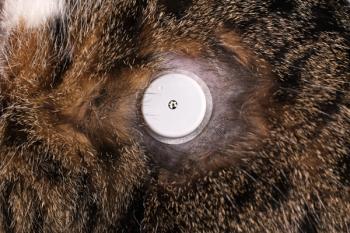
Complications of hyperadrenocorticism (Proceedings)
Naturally occurring hyperadrenocorticism (HAC) is an endocrine disorder resulting from the excess production of cortisol or other adrenal hormones by the adrenal cortex. The clinical syndrome was first documented in people by Dr. Harvey Cushing in 1932 and is also known as Cushing's syndrome.
Naturally occurring hyperadrenocorticism (HAC) is an endocrine disorder resulting from the excess production of cortisol or other adrenal hormones by the adrenal cortex. The clinical syndrome was first documented in people by Dr. Harvey Cushing in 1932 and is also known as Cushing's syndrome. Hyperadrenocorticism in dogs is one of the most common endocrinopathies in small animal practice, and it is also one of the most complicated to diagnose, treat and monitor clinically. Complications can arise from the effects of the disease on many systems, or from therapy. Some of the major complications include hypertension, bacterial infections, urinary calculi, congestive heart failure, pancreatitis, biliary disease, diabetes mellitus, thromboembolic disease, and nervous system signs. This discussion will focus on hypercoagulability, biliary changes, hypertension, and neurologic signs.
Complications
Hypercoagulability and Thromboembolism
Thromboembolic complications including pulmonary thromboembolism (PTE), resulting from hypercoagulability in dogs with HAC increase mortality rate, and are therefore one of the most serious complications of the disease. Studies in people and in dogs have documented many changes to the hemostatic system, mainly changes that contribute to hypercoagulability. In one study in dogs levels of procoagulant factors II, V, VII, IX, X, XII and fibrinogen were significantly increased in dogs with HAC. In addition, antithrombin was decreased and thrombin-antithrombin complexes were increased. Abnormalities in Von Willebrand's Factor and platelet activity have been noted in other studies. Recently investigators have used thromboelastography to document a global tendency to hypercoagulability, but failed to detect a statistically significant difference compared to control dogs.
Signs associated with thromboembolism can relate to any organ system. The most common signs are associated with the respiratory and nervous systems. Pulmonary thromboembolism is considered to be the most common site. Definitive diagnosis can be difficult, but presumptive diagnosis can be made through clinical signs, testing and response to therapy. Routine testing (CBC, chemistry, urinalysis) is non specific but abnormalities that have been noted include anemia, elevated white cells, ALP, ALT, BUN, and creatinine. Decreases in sodium, potassium and albumin have also been noted. Thoracic radiographs may reveal pleural effusion, loss of detail, alveolar infiltrates, cardiomegaly and enlargement of the main pulmonary artery associated with PTE. Thoracic radiographs may also be essentially normal. Echocardiography can also be used to gain evidence for thromboembolism, but results in dogs are variable. Arterial blood gas results are consistent with hypoxemia, mainly attributed to a ventilation-perfusion mismatch. Tests that have been used to confirm thromboembolic disease in dogs include pulmonary angiography, ventilation-perfusion scans, and MRI. Tests used to attempt to confirm a thrombotic tendency include measurement of the procoagulant and anticoagulant factors, measurement of d- dimers, thrombin-antithrombin complexes, and thromboelastography.
The highest risk for thromboembolism is around the time of surgery, for those dogs where surgery is indicated. The goals of therapy are to reverse the prothrombotic state and to alleviate the hemodynamic and pulmonary consequences that are life-threatening. There is little scientific evidence regarding anticoagulant therapy in regards to efficacy in preventing thrombosis, and duration that therapy is necessary for a particular patient considered at risk for thrombosis. Options include antiplatelet therapy (example ultra low dose aspirin) and anticoagulant therapy (example low molecular weight heparin). For thromboembolic disease that has already occurred there is also the potential for use of fibrinolytic agents.
Biliary Changes
In recent years the problem of biliary mucoceles in dogs has been described and analyzed, and has become the most prevalent gall bladder disease in dogs. It is associated with breed predispositions (e.g. Shetland Sheepdogs), hyerlipidemia/hypercholesterolemia due to a variety of underlying diseases and feeding a high fat diet.Dogs with hyperadrenocorticism appear to be more prone to developing gall bladder mucoceles as a complication of the metabolic alterations that occur with HAC. In one study 23% of dogs with hyperadrenocorticism (PDH) were noted to have biliary mucoceles.
There are also individual case reports of dogs with biliary mucocele and HAC concurrently. Recently, a study was performed to analyze bile from dogs that were administered glucocorticoids for extended periods. The bile composition was altered so that there were increases in the amounts of hydrophobic bile acids. These are considered to have cellular toxicity, and may contribute to the necrosis of biliary epithelial cells.
Currently, it is thought that surgical intervention is the best option for dogs with biliary mucoceles. Dogs with concurrent HAC and biliary mucocele should have their HAC controlled to make them better surgical candidates prior to cholecystectomy, if possible. Also, antibiotics should be initiated to control likely bacterial contamination(aerobic and anaerobic spectrum). Ursodeoxycholic acid is thought to be beneficial due to its cholerectic activity, it's effect on gall bladder secretions, and improved gall bladder motility. SAMe is also thought to be beneficial as it is cholerectic.
Hypertension and Proteinuria
Fifty to 80% of dogs with HAC are hypertensive. There may be a variety of pathophysiological reasons for this, but the exact mechanism is unknown. In people with HAC there are multiple factors that may contribute to hypertension including; excessive secretion of renin, activation of the renin-angiotensin system, enhanced vascular sensitivity to pressors, reduction of vasodilator prostaglandins and increased secretion of mineralocorticoids. Hypertension may contribute to glomerular damage and proteinuria. One study noted that there was a significant correlation between the degree of hypertension and the urine protein to creatinine ratio (UPC). Seventy five percent of HAC dogs have been noted to have elevated UPC. Decreases in serum albumin are rare in these cases.
The hypertension and proteinuria resolves in some dogs with HAC that is treated and well controlled but not in every case. In one study, 40% of dogs with well-controlled hyperadrenocorticism were still hypertensive. Hypertension and proteinuria can also be associated with iatrogenic HAC, in dogs treated with chronically high doses of glucocorticoids, and may be reversible depending on the extent of injury.
Neurologic Signs
Various neurologic signs can arise during the clinical course of dogs with HAC. These can be related to the disease itself, treatment with certain medications, or other complications of the disease (e.g. thromboembolic disease).
Occasionally pituitary masses (PDH) will become large and may compress or invade the hypothalamus or other adjacent structures (macrotumor syndrome). Clinical signs associated with this problem can include lack of responsiveness to the owner, listlessness, inappetence, anorexia, restlessness, disorientation, ataxia, pacing, seizures, anisocoria, and strabismus. Diagnosis of this condition relies on ruling out other concurrent diseases or mitotane toxicity. The diagnosis can only be confirmed by advanced imaging with CT or MRI. Pituitary irradiation is an option for dogs with large tumors. There has been success with this method, but it does appear to relate to the size of the tumor at diagnosis and the severity of clinical signs prior to initiating therapy. These dogs may concurrently require anti-seizure medication and mitotane or trilostane as the effects of the radiation therapy can be delayed.
Neurologic signs may also be due to therapy with mitotane. Overdosage of mitotane can cause weakness and ataxia. It has also been noted that neurologic signs can be seen several weeks into therapy. This is possibly due to the growth of the pituitary tumor.
References available on request
Newsletter
From exam room tips to practice management insights, get trusted veterinary news delivered straight to your inbox—subscribe to dvm360.





